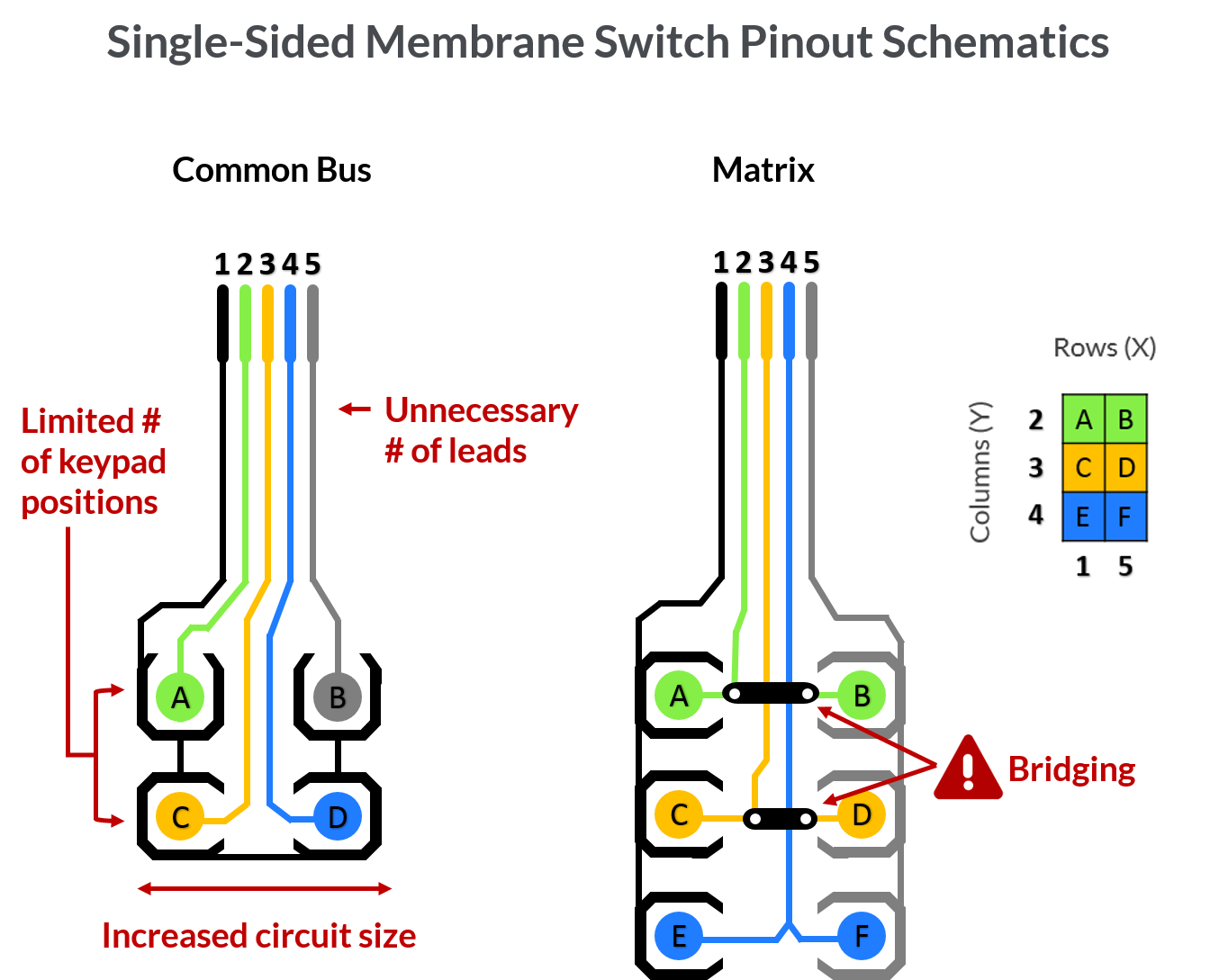Skilled Membrane Switch Manufacturer for Advanced Projects
Just How Membrane Switch Modern Technology Functions and Its Function in Individual User Interface Style
Membrane button innovation is an advanced technique that incorporates layered materials for touch-sensitive input. Its style includes visuals overlays, conductive layers, and glue elements that interact when pressed. This communication not only completes an electrical circuit yet likewise affects the total user experience. Comprehending the ins and outs of this innovation exposes its substantial impact on individual interface design, prompting inquiries regarding its applications and future growths in various markets.
Comprehending Membrane Switch Technology
Membrane switch innovation offers as an essential element in modern-day customer interface style. This modern technology integrates visuals overlays, touch-sensitive membranes, and circuit layers to produce a portable, reputable input technique for different devices. The style typically includes several layers, including a published graphic layer that permits individuals to engage with the tool via responsive feedback. Membrane switches are understood for their sturdiness, resistance to dampness, and convenience of cleansing, making them appropriate for atmospheres where traditional mechanical switches might fall short. Their inconspicuous layout enables seamless integration into gadgets, adding to a smooth appearance. Additionally, Membrane switches can be tailored with numerous shades, appearances, and icons, boosting user experience and visual charm. This flexibility makes them preferred in consumer electronics, clinical tools, and industrial controls, where intuitive interaction is important. On the whole, Membrane button innovation represents a significant improvement in just how customers involve with electronic user interfaces.
Secret Components of Membrane Switches
Membrane switches over include numerous vital elements that add to their functionality and design. The conductive layer products, sticky and assistance layers, and visuals overlay layout each play a crucial duty in guaranteeing excellent performance and individual interaction. Understanding these elements is vital for effective interface layout.
Conductive Layer Products
Conductive layer products play a crucial duty in the functionality and dependability of Membrane buttons. When stress is applied to the button, these materials are accountable for finishing electrical circuits. Normally, a combination of conductive inks, such as silver or carbon, is used to develop these layers. Silver conductive ink is favored for its superior conductivity and sturdiness, while carbon ink is typically utilized for affordable applications. The selection of product affects not only the electrical efficiency but additionally the overall life-span of the button. In addition, the density and make-up of conductive layers can affect tactile comments and switch actuation. Selecting the appropriate conductive product is crucial for ensuring perfect efficiency in diverse interface applications.
Glue and Support Layers
Sticky and support layers are essential parts that add to the structural integrity and functionality of Membrane switches. These layers offer a robust structure, ensuring that the numerous elements of the Membrane switch stay safely bonded and effectively lined up throughout their operational life. The glue layer facilitates the attachment of the button to the underlying surface, offering resilience versus environmental elements such as moisture, temperature level variations, and mechanical anxiety. Meanwhile, assistance layers improve the switch's rigidness, stopping contortion during use and contributing to a consistent responsive reaction. Together, these elements play a crucial duty in keeping the efficiency and long life of Membrane switches, inevitably influencing the general customer experience in interface style.
Graphic Overlay Style
Frequently ignored, graphic overlay design plays an essential function in the capability and aesthetic appeals of Membrane buttons. This layout largely works as the user interface between the user and the electronics, offering both aesthetic allure and functional clarity. Reliable graphic overlays use color, typography, and symbols to lead individuals in recognizing and steering controls gadget functions. In addition, the selection of materials impacts sturdiness and tactile responses, making certain the overlay holds up against wear while preserving a pleasant individual experience. In addition, accurate alignment of the overlay with the underlying components is crucial for ideal efficiency. Finally, thoughtful visuals overlay layout enhances usability, adds to brand name identification, and inevitably affects user satisfaction in tools utilizing Membrane button modern technology.
The Manufacturing Refine of Membrane Switches Over
The manufacturing process of Membrane changes entails several crucial steps that ensure capability and resilience. A graphic overlay is designed, integrating customer interface aspects and branding. This overlay is printed onto a flexible substrate, typically polyester or polycarbonate, utilizing precision printing techniques to determine clearness and shade accuracy.Next, adhesive layers are used, followed by the integration of conductive traces, usually made from silver or carbon, which are vital for electric connectivity. These traces are screen-printed or etched onto a different layer. Hereafter, a spacer layer is included to develop the essential gap between the circuit and the overlay layer, enabling responsive responses when activated.Finally, the parts are constructed and examined for quality control, ensuring that each Membrane switch fulfills the called for specs for efficiency and dependability. This thorough process leads to a durable product fit for different applications in interface design.
Advantages of Making Use Of Membrane Changes

Membrane switches offer various benefits that make them a favored selection in customer interface design. One significant benefit is their lightweight and portable nature, permitting for streamlined layouts in different applications. Furthermore, Membrane buttons provide a secured user interface, securing against dust, dampness, and contaminants, which boosts longevity and reliability. They are likewise extremely customizable, making it possible for developers to produce one-of-a-kind graphics and designs customized to details customer needs.Another advantage is their cost-effectiveness, as they usually need less product and labor compared to traditional buttons. The tactile responses of Membrane switches can be engineered to enhance customer experience, using a satisfying response without the bulk of mechanical components. Membrane buttons can be quickly incorporated into diverse settings, such as medical gadgets, industrial devices, and consumer electronics. Overall, these benefits highlight the expanding appeal of Membrane switches in modern user interface design.
Applications in Numerous Industries
Widely made use of throughout various sectors, Membrane switch innovation has found its location in applications varying from medical devices to consumer electronic devices. In the health care market, these switches are integral to devices such as analysis devices and client monitoring systems, providing durable, easy-to-clean user interfaces that endure sterilization procedures. The automotive market utilizes Membrane buttons in control panels and control board, offering reliable operation in tough environments.Consumer electronic devices, consisting of home devices and video gaming consoles, gain from the streamlined design and customizability of Membrane buttons, boosting customer interaction. In addition, commercial machinery uses these switches for control board, guaranteeing resistance to dust and wetness while keeping functionality.Moreover, the aerospace and armed forces fields use Membrane buttons for rugged applications, where helpful site reliability and performance are crucial. In general, Membrane button technology serves diverse industries by integrating capability, longevity, and visual allure, making it a flexible choice for modern-day interface.

Creating Interface With Membrane Switches Over
When developing individual interfaces with Membrane switches, mindful consideration of both performance and visual appeal is important. Membrane switches provide a smooth, inconspicuous style that can enhance aesthetic allure while keeping usability. Developers have to concentrate on button design, making certain intuitive placement for ease of procedure. The responsive feedback provided by the Membrane switch is essential; it can affect individual fulfillment and general experience.Additionally, color and visuals components need to line up with the brand name identity, strengthening recognition and familiarity. Picking sturdy materials that withstand damage is also crucial, as long life contributes to usability over time. Incorporating backlighting can improve presence official statement in numerous lights problems, even more enhancing user interaction. Inevitably, a properly designed Membrane switch user interface equilibriums both kind and feature, ensuring that the customer experience is both efficient and appealing, fulfilling the needs of varied applications across industries.
Future Patterns in Membrane Switch Innovation
As Membrane button innovation advances, the assimilation of wise functionalities is coming to be progressively famous. These improvements allow improved interactivity and connectivity within interface (membrane switch manufacturer). Furthermore, the change in the direction of eco-friendly products mirrors an expanding dedication to sustainability in style techniques
Smart Membrane Changes

Eco-Friendly Materials Usage
Amidst the advancements in Membrane switch innovation, a significant pattern is emerging towards the usage of environmentally friendly materials. Suppliers are progressively focusing on sustainability by incorporating safe inks and naturally degradable plastics, lowering ecological effect. This shift not just straightens with international environmental requirements however likewise addresses customer need for greener items. Advancements in material science have made it possible for the advancement of durable, eco-friendly choices that maintain efficiency without endangering top quality. These products offer comparable capability to typical choices while minimizing waste and poisoning. As industries end up being much more eco-conscious, the integration of lasting practices in Membrane switch manufacturing is anticipated to rise, strengthening a commitment to environmental obligation and leading the way for more lasting user interface remedies in the future.
Often Asked Questions
Just How Do Membrane Switches Over Differ From Traditional Mechanical Buttons?
Membrane changes differ from standard mechanical buttons mostly in construction and operation. They use versatile layers that create a secured user interface, whereas mechanical switches rely upon physical movement and contact, causing distinctive durability and responsive responses features.
Can Membrane Switches Be Customized for Details Applications?
Membrane buttons can indeed be customized for particular applications - membrane switch manufacturer. Manufacturers design them to satisfy unique requirements, enabling for customized formats, graphics, and capabilities that enhance individual communication and fit certain operational demands successfully
What Is the Lifespan of a Membrane Layer Switch?
The lifespan of a membrane switch commonly ranges from 1 to 5 million actuations, depending upon variables such as worldly top quality, ecological problems, and usage regularity. Routine testing can assist identify its longevity and dependability in applications.
Are Membrane Switches Waterproof or Immune to Chemicals?
Membrane buttons can be designed to be waterproof and immune to chemicals, depending on the products utilized and manufacturing procedures. Proper securing and protective finishes improve their toughness in numerous ecological conditions and applications.
Exactly How Do Membrane Changes Effect Gadget Power Consumption?
Membrane buttons can greatly impact tool power consumption by ensuring effective procedure. Their reduced power needs throughout activation assistance minimize power use, adding to longer battery life and general improved performance in electronic gadgets. Membrane buttons are recognized for their sturdiness, resistance to moisture, and simplicity of cleaning, making them appropriate for atmospheres where typical mechanical switches might fail. The automotive sector uses Membrane switches in control panels and control panels, providing trustworthy procedure in tough environments.Consumer electronic devices, including home devices and video gaming consoles, benefit from the streamlined design and customizability of Membrane buttons, boosting customer interaction. In addition, industrial equipment makes use of these switches for control panels, making sure resistance to dirt and wetness while maintaining functionality.Moreover, the aerospace and military fields make use of Membrane switches for sturdy applications, where integrity and efficiency are vital. The advancement of Membrane button innovation is entering an interesting phase with the emergence of smart Membrane buttons, which incorporate sophisticated features and functionalities. Membrane changes differ from typical mechanical visit this web-site switches primarily in building and construction and operation.